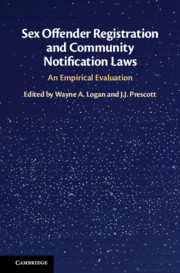Book contents
- Sex Offender Registration and Community Notification Laws: An Empirical Evaluation
- Sex Offender Registration and Community Notification Laws
- Copyright page
- Contents
- Contributors
- Preface
- Acknowledgments
- 1 Origins and Evolution
- 2 Variations in the Structure and Operation of SORN Systems
- 3 Registries and Registrants:
- 4 Law Enforcement and SORN
- 5 The Public and SORN Laws
- 6 The Ancillary Consequences of SORN
- 7 Offenders and SORN Laws
- 8 Integrating the Etiology of Sexual Offending into Evidence-Based Policy and Practices
- 9 Juvenile Registration and Notification Are Failed Policies That Must End
- Conclusion
- Index
- References
2 - Variations in the Structure and Operation of SORN Systems
Published online by Cambridge University Press: 11 June 2021
- Sex Offender Registration and Community Notification Laws: An Empirical Evaluation
- Sex Offender Registration and Community Notification Laws
- Copyright page
- Contents
- Contributors
- Preface
- Acknowledgments
- 1 Origins and Evolution
- 2 Variations in the Structure and Operation of SORN Systems
- 3 Registries and Registrants:
- 4 Law Enforcement and SORN
- 5 The Public and SORN Laws
- 6 The Ancillary Consequences of SORN
- 7 Offenders and SORN Laws
- 8 Integrating the Etiology of Sexual Offending into Evidence-Based Policy and Practices
- 9 Juvenile Registration and Notification Are Failed Policies That Must End
- Conclusion
- Index
- References
Summary
Chapter 2 explores the structure and evolution of federal, state, and international SORN policies. The chapter first outlines the history of federal legislation in the United States that has shaped the current SORN environment, beginning with the 1994 Jacob Wetterling Act and continuing through the 2006 Sex Offender Registration and Notification Act (SORNA) and its subsequent amendments. The chapter then explores the key points of variation in state SORN policies, underscoring the elusive nature of fulfilling SORNA’s vision of a uniform national system. This analysis examines two particularly prominent points of interstate variation: provisions for the registration of juveniles and mechanisms for registrant classification. The chapter concludes with a brief examination of SORN systems outside the United States, indicating that, although many countries have adopted provisions for requiring registration with law enforcement, the provision of public access to registrant information is far less common.
Keywords
- Type
- Chapter
- Information
- Sex Offender Registration and Community Notification LawsAn Empirical Evaluation, pp. 17 - 34Publisher: Cambridge University PressPrint publication year: 2021

